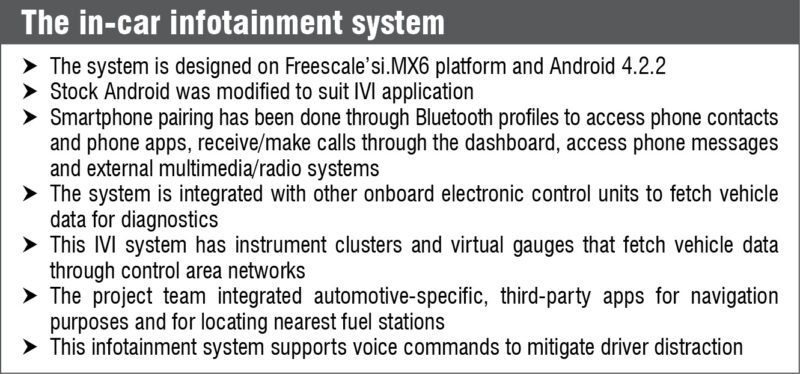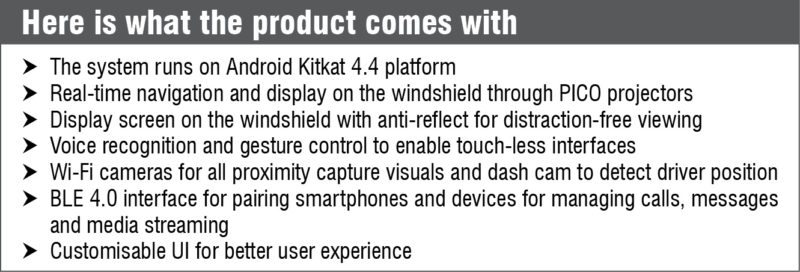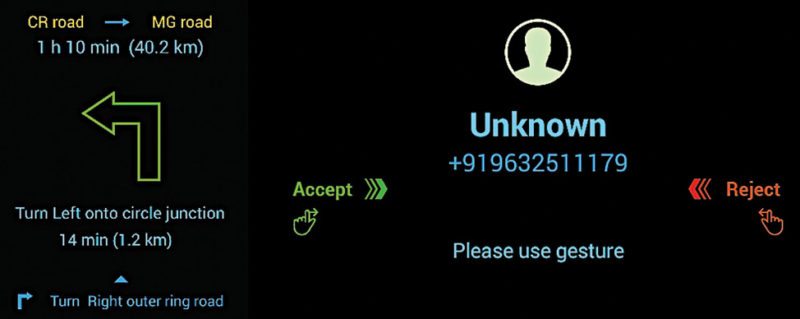Let us imagine a fine day when you are going with family to a picnic in a car. Music and movies keep the kids entertained. When they need a change of song or movie, they just wave through the air. Meanwhile, the family member driving the car can ensure that the car is moving on the right path and at the right speed, without taking eyes off the road, even to glance at the GPS, by using the car HUD.
Embitel’s solution to enable a smarter and safer vehicle features such a smart infotainment system that visually integrates with the car’s windshield. The system also connects to the vehicle’s electronics and leverages the Android experience to which any user could easily get accustomed.
While discussing innovations at Embitel with Vidya Sagar, who heads connected car and automation-related initiatives, an interesting story of how innovative concepts could be engineered to suit business reality unfolded.
Let us take a look at the journey the innovators took.
Bringing life into the system
About six years ago, the engineers at Embitel found the need for an in-vehicle infotainment (IVI) system that would bundle the media requirements of drivers as well as the passengers in a car. At that time, most people were enthralled by the introduction of Android based smartphones. These smartphones housed operating functionalities that fulfilled all their media and connectivity requirements with an interactive graphical user interface (GUI).
As the flame of ideas grew brighter, teams at Embitel realised that they must build their infotainment system around Android operating system due to its open source nature and easy integration with third-party stacks. Past expertise and in-depth analysis were taken into account and the project for creating an automotive multimedia application took shape.
In the long run, this decision proved to be a viable business case. Embitel’s product engineering services team successfully delivered their first automotive infotainment system in the year 2014 for a tier 1 supplier.
What’s surprising is that they were able to do this while Google themselves are yet to launch Android N for automotive systems, with just a prototype demonstration available as of May 2016.
The connectivity aspect
Data is acquired from onboard diagnostic board and controller area network bus on the vehicle. Every typical car has these on board, which is a network of points. There are electronic control units within the vehicle, which control doors, vipers, power train and so on. These provide crucial data to the hub, and the processing follows.
Added awareness. The product’s awareness features work on data analytics, driven by two major paradigms. One focuses on real-time analytics for quick decision making and the other works on studying the pattern of usage in order to benchmark against reported events or trend analysis. Once the trend analysis is inferred, predictive analytics can also be enforced.
On another track, companies providing maintenance, insurance, etc could tap into this system and thereby work out strategies to better service the customers based on the way they handle their vehicles.

The system has capabilities to flag certain non-compliant events that could endanger the vehicle such as a faulty door/engine speed-limit infringement, and initiate emergency notifications. Critical minutes of an unfavourable event happening to the vehicle and the passengers are reduced in this process, reducing changes of accidents. The system is programmed to feed in emergency contacts so that help reaches the spot where the vehicle was last reported. This is done by combining software, hardware and Cloud connectivity powered by analytics. Media, connectivity skills and embedded skills, all contribute to designing this system.
The next step
Towards the end of the infotainment project, the teams involved asked themselves a rather simple and regular question: “How can these features be designed better to add more value to end users—how can we further improve the driving experience?”

Amidst all the discussions and research, the teams started toying with the idea of a more sophisticated display that also enhances safety. A return to the sketchboard showed that there were very few after-market head-up display (HUD) products, and most had a cluttered and user-unfriendly UI design.
Leveraging the experience of the infotainment project, Embitel developed a clutter-free and user-friendly hardware and software design of Car HUD. You can see the layout and design in Fig. 1. Although the final design looks simple, the process to come up with such a design involved a lot of work.

This proprietary design is production-ready and is of automotive-grade. This ensures that a customer can launch the Car HUD product in six months.
The car HUD displays real-time driving data coupled with road signs and lane departure alerts as it continuously monitors the set safety parameters. The touch-less commands through their integrated gesture-control and voice-recognition modules are able to give a hands-free seamless experience without distractions of any kind.
Users can dictate their response, attend/reject calls using simple hand motions or ask the unit to read these via a voice assist. The microphone picks up the voice from the user and directs it to a voice-recognition unit than then processes the voice. Operations are performed once the particular command key words are identified. Commands are recognised and interpreted using the data dictionary to perform actions, which can be as simple as saying Accept or Reject (the call). The UI is equally responsive.

Heads up to the future of Car HUD
Embitel Technologies started its journey in 2006. Since then the product engineering services business has collaborated with global customers for R&D and embedded product development services in automotive and home/factory automation areas.
The cross-functional expertise in mobile and Cloud connectivity technologies has helped add value to the customer base with solutions for the Internet of Things (IoT) for home automation, healthcare, infotainment, telematics, advanced driver assistance systems and connected cars. It remains to be seen how the market evolves, now that Google is about to come up with their own solution!
If you like this article, you may also like: Electronics in Cars
Shanosh Kumar is technology journalist at EFY.






